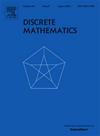On a family of automatic apwenian sequences
IF 0.7
3区 数学
Q2 MATHEMATICS
引用次数: 0
Abstract
An integer sequence is called apwenian if and for all . The apwenian sequences are connected with the Hankel determinants, the continued fractions, the rational approximations and the measures of randomness for binary sequences. In this paper, we study the automatic apwenian sequences over different alphabets. On the alphabet , we give an extension of the generalized Rueppel sequences and characterize all the 2-automatic apwenian sequences in this class. On the alphabet , we prove that the only apwenian sequence, among all fixed points of substitutions of constant length, is the period-doubling like sequence. On the other alphabets, we give a description of the 2-automatic apwenian sequences in terms of 2-uniform morphisms. Moreover, we find two 3-automatic apwenian sequences on the alphabet .
求助全文
约1分钟内获得全文
求助全文
来源期刊

Discrete Mathematics
数学-数学
CiteScore
1.50
自引率
12.50%
发文量
424
审稿时长
6 months
期刊介绍:
Discrete Mathematics provides a common forum for significant research in many areas of discrete mathematics and combinatorics. Among the fields covered by Discrete Mathematics are graph and hypergraph theory, enumeration, coding theory, block designs, the combinatorics of partially ordered sets, extremal set theory, matroid theory, algebraic combinatorics, discrete geometry, matrices, and discrete probability theory.
Items in the journal include research articles (Contributions or Notes, depending on length) and survey/expository articles (Perspectives). Efforts are made to process the submission of Notes (short articles) quickly. The Perspectives section features expository articles accessible to a broad audience that cast new light or present unifying points of view on well-known or insufficiently-known topics.
 求助内容:
求助内容: 应助结果提醒方式:
应助结果提醒方式:


